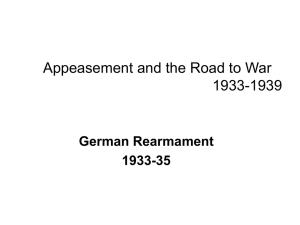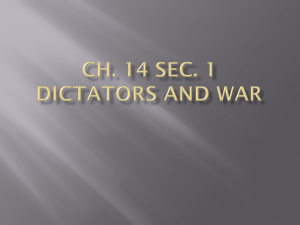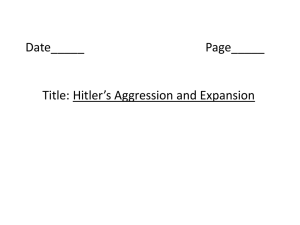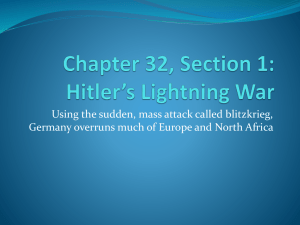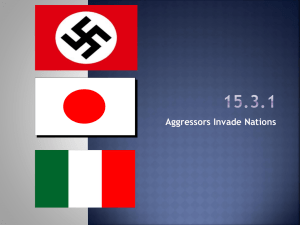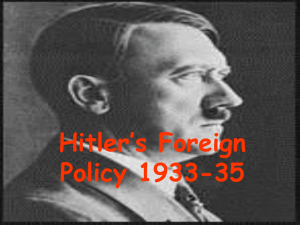Hitler`s actions, 1933
advertisement
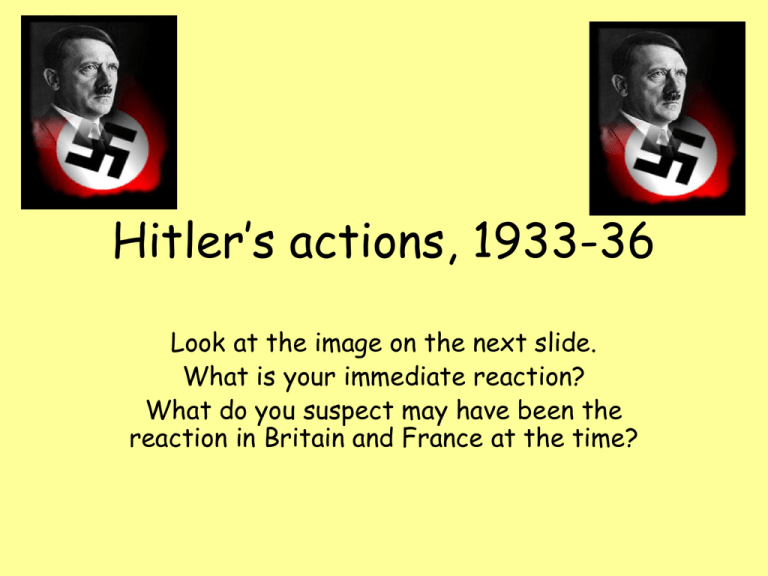
Hitler’s actions, 1933-36 Look at the image on the next slide. What is your immediate reaction? What do you suspect may have been the reaction in Britain and France at the time? German soldiers and armaments on show at the Proclamation of Freedom to Rearm Rally in 1935. Task • Over the next few lessons, we are going to be looking at Hitler’s actions after coming to power in 1933. • You are to make a set of detailed notes on these actions to prepare to deliver a news broadcast in groups, explaining how these actions brought Europe to War in 1939. • The broadcast will deliver ‘news flashes’ throughout the period and will present the news on the following incidents – Rearmament The Saar plebiscite The remilitarisation of the Rhineland The Spanish Civil War Anschluss with Austria • Any additional research that you complete in the mean time will make your understanding, and therefore your grade, much better. What does this source suggest about the British reaction to German rearmament? SOURCE 2 I am convinced that Hitler does not want war . . . what the Germans are after is a strong army which will enable them to deal with Russia. British politician Lord Lothian, January 1935. Helps solve unemployment Rearmament helped boost support for the Nazi Party. Why did Hitler choose to pursue a policy of massive rearmament? Hitler is seen delivering on his promise to make Germany strong again Hitler is seen as challenging the hated Treaty of Versailles Why did Hitler get away with rearmament? • What factors allowed Hitler to get away with rearming Germany? • • • • • • Look at page 48 in Walsh. Rearmament began in secret at first Hitler was only rearming as other countries refused to disarm Lots of countries were using rearmament as a means of combating unemployment • • • Hitler walked out of the League of Nations Disarmament Conference and the League altogether in 1933 Britain sympathised with Germany and believed that the Treaty of Versailles had been too harsh Britain also thought that a strong Germany would provide a buffer against communism. Britain had already helped to dismantle the Treaty by signing a naval agreement with Hitler in 1935 allowing Germany to increase its navy to up to 35% of the size of the British navy The French were angry but there was little they could do. Hitler’s actions, 1933-36 • Withdrew from the League of Nations and Disarmament Conference (1933); • Tried unsuccessfully to stage a pro-Nazi coup in Austria (1934); • Won a plebiscite on the future of the Saar, which voted 90% to be German (1935); • Announced German re-armament, including an airforce (1935) and conscription (1936); • Agreed an increase in Germany’s navy with Britain (1935), allowing Germany to have as many submarines as Britain, and 35% of its ships (Anglo-German Naval Agreement) How did the allies react? In only two cases was there serious opposition to these moves. First, Mussolini’s objections prevented Hitler taking over Austria in 1934 (he later did this in 1938). Second, Italy, France and Britain formed the Stresa Front in 1935 in response to re-armament to demonstrate their concern. However, for the most part, these countries either made token protests or even endorsed Germany’s moves (the Anglo-German Naval Agreement was a British agreement to Germany re-arming, contrary to Versailles). The USSR’s response to all of this was finally to join the League of Nations in 1934. Task • Design a Nazi poster to present the information in source 10 to the German people. • The poster must be completed for homework. • Look at the following contemporary sources to give you inspiration… The map is titled “Demilitarized Germany.” The shaded areas are regions demilitarized under the Treaty of Versailles. The caption says: “With an insufficient military, Germany can be blockaded both by land and sea.” Germany had suffered considerably during World War I under the Allied blockade, something the map suggests could happen again. The black areas are industrial zones. The caption reads: “Germany’s industrial areas, unlike those of France, are defenseless in defortified or even demilitarized border zones.” The table is titled “Military expenditures by the great powers.” The chart to the left is per capita military expenditures, the chart to the right military expenditures as a percentage of the overall budget. The chart suggests that Germany is being greatly outspent by the countries around it. Plenary • What were Hitler’s aims in foreign policy? • G? • U? • L? • D?


